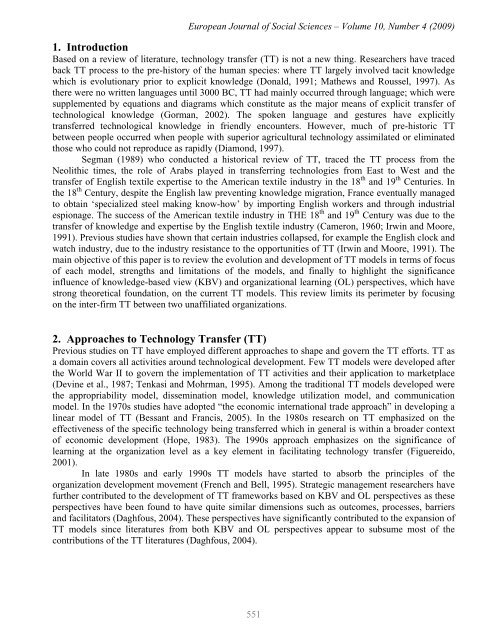A Review on the Technology Transfer Models ... - EuroJournals
A Review on the Technology Transfer Models ... - EuroJournals
A Review on the Technology Transfer Models ... - EuroJournals
Create successful ePaper yourself
Turn your PDF publications into a flip-book with our unique Google optimized e-Paper software.
European Journal of Social Sciences – Volume 10, Number 4 (2009)<br />
1. Introducti<strong>on</strong><br />
Based <strong>on</strong> a review of literature, technology transfer (TT) is not a new thing. Researchers have traced<br />
back TT process to <strong>the</strong> pre-history of <strong>the</strong> human species: where TT largely involved tacit knowledge<br />
which is evoluti<strong>on</strong>ary prior to explicit knowledge (D<strong>on</strong>ald, 1991; Ma<strong>the</strong>ws and Roussel, 1997). As<br />
<strong>the</strong>re were no written languages until 3000 BC, TT had mainly occurred through language; which were<br />
supplemented by equati<strong>on</strong>s and diagrams which c<strong>on</strong>stitute as <strong>the</strong> major means of explicit transfer of<br />
technological knowledge (Gorman, 2002). The spoken language and gestures have explicitly<br />
transferred technological knowledge in friendly encounters. However, much of pre-historic TT<br />
between people occurred when people with superior agricultural technology assimilated or eliminated<br />
those who could not reproduce as rapidly (Diam<strong>on</strong>d, 1997).<br />
Segman (1989) who c<strong>on</strong>ducted a historical review of TT, traced <strong>the</strong> TT process from <strong>the</strong><br />
Neolithic times, <strong>the</strong> role of Arabs played in transferring technologies from East to West and <strong>the</strong><br />
transfer of English textile expertise to <strong>the</strong> American textile industry in <strong>the</strong> 18 th and 19 th Centuries. In<br />
<strong>the</strong> 18 th Century, despite <strong>the</strong> English law preventing knowledge migrati<strong>on</strong>, France eventually managed<br />
to obtain ‘specialized steel making know-how’ by importing English workers and through industrial<br />
espi<strong>on</strong>age. The success of <strong>the</strong> American textile industry in THE 18 th and 19 th Century was due to <strong>the</strong><br />
transfer of knowledge and expertise by <strong>the</strong> English textile industry (Camer<strong>on</strong>, 1960; Irwin and Moore,<br />
1991). Previous studies have shown that certain industries collapsed, for example <strong>the</strong> English clock and<br />
watch industry, due to <strong>the</strong> industry resistance to <strong>the</strong> opportunities of TT (Irwin and Moore, 1991). The<br />
main objective of this paper is to review <strong>the</strong> evoluti<strong>on</strong> and development of TT models in terms of focus<br />
of each model, strengths and limitati<strong>on</strong>s of <strong>the</strong> models, and finally to highlight <strong>the</strong> significance<br />
influence of knowledge-based view (KBV) and organizati<strong>on</strong>al learning (OL) perspectives, which have<br />
str<strong>on</strong>g <strong>the</strong>oretical foundati<strong>on</strong>, <strong>on</strong> <strong>the</strong> current TT models. This review limits its perimeter by focusing<br />
<strong>on</strong> <strong>the</strong> inter-firm TT between two unaffiliated organizati<strong>on</strong>s.<br />
2. Approaches to <strong>Technology</strong> <strong>Transfer</strong> (TT)<br />
Previous studies <strong>on</strong> TT have employed different approaches to shape and govern <strong>the</strong> TT efforts. TT as<br />
a domain covers all activities around technological development. Few TT models were developed after<br />
<strong>the</strong> World War II to govern <strong>the</strong> implementati<strong>on</strong> of TT activities and <strong>the</strong>ir applicati<strong>on</strong> to marketplace<br />
(Devine et al., 1987; Tenkasi and Mohrman, 1995). Am<strong>on</strong>g <strong>the</strong> traditi<strong>on</strong>al TT models developed were<br />
<strong>the</strong> appropriability model, disseminati<strong>on</strong> model, knowledge utilizati<strong>on</strong> model, and communicati<strong>on</strong><br />
model. In <strong>the</strong> 1970s studies have adopted “<strong>the</strong> ec<strong>on</strong>omic internati<strong>on</strong>al trade approach” in developing a<br />
linear model of TT (Bessant and Francis, 2005). In <strong>the</strong> 1980s research <strong>on</strong> TT emphasized <strong>on</strong> <strong>the</strong><br />
effectiveness of <strong>the</strong> specific technology being transferred which in general is within a broader c<strong>on</strong>text<br />
of ec<strong>on</strong>omic development (Hope, 1983). The 1990s approach emphasizes <strong>on</strong> <strong>the</strong> significance of<br />
learning at <strong>the</strong> organizati<strong>on</strong> level as a key element in facilitating technology transfer (Figuereido,<br />
2001).<br />
In late 1980s and early 1990s TT models have started to absorb <strong>the</strong> principles of <strong>the</strong><br />
organizati<strong>on</strong> development movement (French and Bell, 1995). Strategic management researchers have<br />
fur<strong>the</strong>r c<strong>on</strong>tributed to <strong>the</strong> development of TT frameworks based <strong>on</strong> KBV and OL perspectives as <strong>the</strong>se<br />
perspectives have been found to have quite similar dimensi<strong>on</strong>s such as outcomes, processes, barriers<br />
and facilitators (Daghfous, 2004). These perspectives have significantly c<strong>on</strong>tributed to <strong>the</strong> expansi<strong>on</strong> of<br />
TT models since literatures from both KBV and OL perspectives appear to subsume most of <strong>the</strong><br />
c<strong>on</strong>tributi<strong>on</strong>s of <strong>the</strong> TT literatures (Daghfous, 2004).<br />
551

















